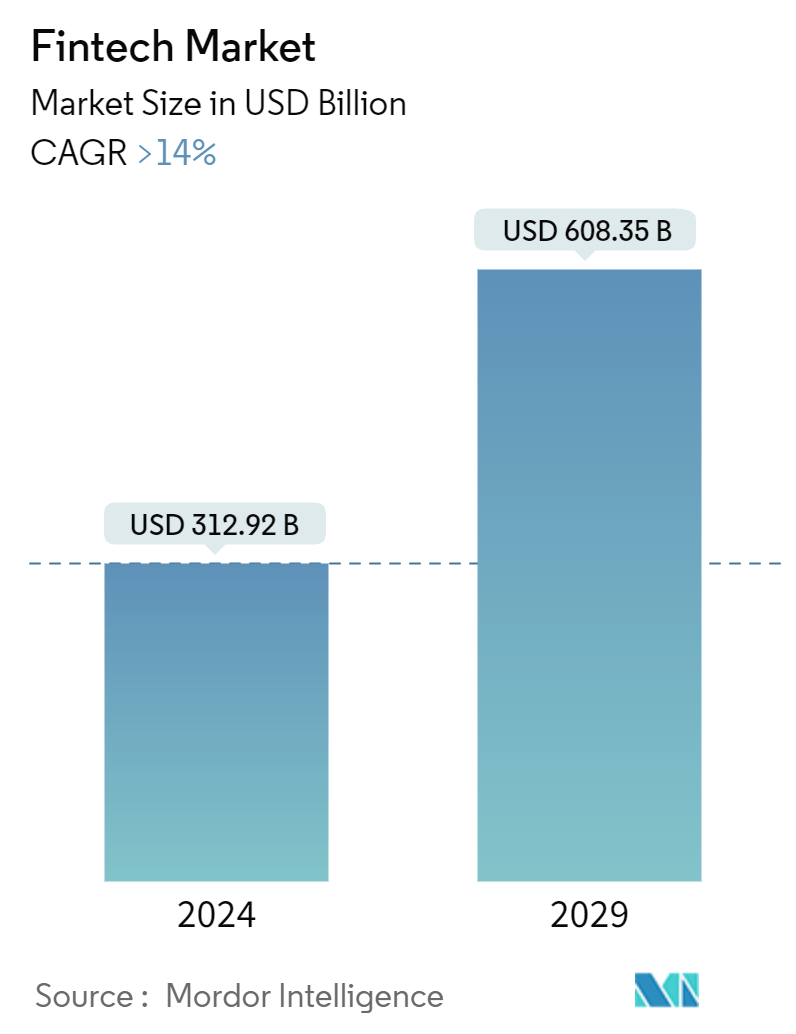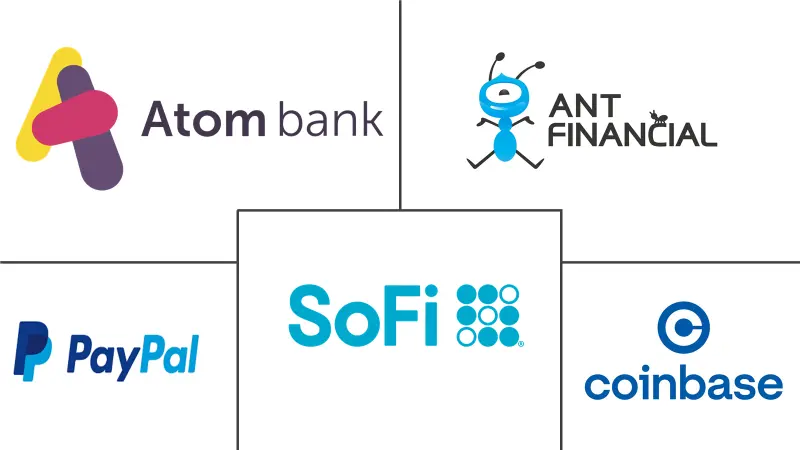Market Size of Fintech Industry

| Study Period | 2020 - 2029 |
| Market Size (2024) | USD 312.92 Billion |
| Market Size (2029) | USD 608.35 Billion |
| CAGR (2024 - 2029) | 14.00 % |
| Fastest Growing Market | Asia Pacific |
| Largest Market | North America |
Major Players
*Disclaimer: Major Players sorted in no particular order |
Fintech Industry Analysis
The Fintech Market size is estimated at USD 312.92 billion in 2024, and is expected to reach USD 608.35 billion by 2029, at a CAGR of greater than 14% during the forecast period (2024-2029).
In the financial industry, fintech stands for financial technology. In businesses that offer automated and enhanced financial services, fintech refers to computer programs and other contemporary technologies. The fintech industry overview shows that the sector has developed significantly over time, which has caused businesses to become more customer focused. It is, therefore, difficult to find a position among the many businesses that exist worldwide, which range from startups to tech enterprises to well-established businesses. As the fintech market size grows, fintech and financial service organizations have pursued disruptive and new ideas in an ever-changing business landscape, taking up each other's lanes with either a collaborative or a competing attitude.
Multiple crises have served as a driving force behind the growth of the fintech industry. Fintech investments have been rising since the last global financial crisis. The traditional financial services sector was severely pressed both during and after the crisis, and its weaknesses led to a technological reaction that resulted in the sector's expansion. According to the fintech market research report the COVID-19 pandemic also had a disastrous effect on the global economy, which started the recession. The fintech industry developed more quickly because of this crisis. Large financial institutions collaborated with up-and-coming tech firms in response to the pandemic to gain access to the new market. The fintech business is growing even though companies themselves are looking to collaborate with big banks to broaden their clientele and offerings.
In recent years, numerous fintech subtypes, such as Insurtech, RecTech, payment services, and others, have been employing cutting-edge technologies customized for certain industries or roles. The degree of execution attained in an organization's plan is becoming more significant now that the fintech sector is more than just a fad. The financial technology industry is experiencing rapid growth on its technological side. There has been an increased adoption of technology that allows for better accuracy, efficiency, and agility, such as blockchain, process automation, application programming interface (API), robotics, and data analytics in the financial technology industry.
Fintech Industry Segmentation
The term fintech (financial technology) is used to refer to computer programs and other modern technologies used by different businesses that offer automated and improved financial services.
The global fintech market can be segmented based on service proposition and geography. By service proposition, the financial technology industry is segmented into money transfer and payments, savings and investments, digital lending and lending marketplaces, online insurance and insurance marketplaces, and other service propositions. By geography, the market is segmented into Europe, Asia-Pacific, North America, Latin America, and the Middle East and Africa. The fintech market research report offers fintech market size and forecasts in value terms (USD) for all the above-mentioned segments.
| By Service Proposition | |
| Money Transfer and Payments | |
| Savings and Investments | |
| Digital Lending and Lending Marketplaces | |
| Online Insurance and Insurance Marketplaces | |
| Other Service Propositions |
| By Geography | |||||||
| |||||||
| |||||||
| |||||||
| |||||||
|
Fintech Market Size Summary
The fintech industry, representing the intersection of finance and technology, has seen substantial growth and transformation over recent years. This sector encompasses a wide range of services, from automated financial solutions to advanced technologies like blockchain and data analytics, which have become integral to enhancing efficiency and customer experience. The industry's expansion is driven by the need for innovative financial services that cater to underserved populations, including the unbanked and underbanked. Digital payments, in particular, have revolutionized the sector by offering faster, more secure, and cost-effective transaction methods, thereby facilitating greater financial inclusion and accessibility. The fintech market is characterized by a dynamic landscape where traditional financial institutions and tech-driven companies either collaborate or compete to capture market share and expand their service offerings.
The Asia-Pacific region is emerging as a significant hub for fintech innovation, propelled by a rapidly growing digital economy and supportive government initiatives. Countries like China, India, Singapore, and Australia are at the forefront, attracting investments and talent while fostering a conducive environment for fintech growth through favorable regulatory frameworks. These developments are part of a broader global trend where fintech companies are leveraging technological advancements and strategic partnerships to drive market expansion. The industry's trajectory is further influenced by ongoing technological innovations, evolving consumer preferences, and regulatory developments, positioning fintech as a transformative force in the financial services landscape.
Fintech Market Size - Table of Contents
-
1. MARKET INSIGHTS AND DYNAMICS
-
1.1 Market Overview
-
1.2 Market Drivers
-
1.2.1 Rise of Digital Payments
-
1.2.2 Rising Investments in FinTech Firms
-
-
1.3 Market Restraints
-
1.3.1 Intense Competition
-
1.3.2 Increasing Cybersecurity Risks
-
-
1.4 Market Opportunites
-
1.4.1 Evolving Blockchain Technology and Cryptocurrency
-
1.4.2 Collaboration with Traditional Financial Institutions
-
-
1.5 Value Chain Analysis
-
1.6 Industry Attractiveness - Porter's Five Forces Analysis
-
1.6.1 Threat of New Entrants
-
1.6.2 Bargaining Power of Buyers/Consumers
-
1.6.3 Bargaining Power of Suppliers
-
1.6.4 Threat of Substitute Products
-
1.6.5 Intensity of Competitive Rivalry
-
-
1.7 Insights into Technological Innovations in the Market
-
1.8 Impact of COVID-19 on the Market
-
-
2. MARKET SEGMENTATION
-
2.1 By Service Proposition
-
2.1.1 Money Transfer and Payments
-
2.1.2 Savings and Investments
-
2.1.3 Digital Lending and Lending Marketplaces
-
2.1.4 Online Insurance and Insurance Marketplaces
-
2.1.5 Other Service Propositions
-
-
2.2 By Geography
-
2.2.1 North America
-
2.2.1.1 United States
-
2.2.1.2 Canada
-
2.2.1.3 Rest of North America
-
-
2.2.2 Europe
-
2.2.2.1 United Kingdom
-
2.2.2.2 Germany
-
2.2.2.3 France
-
2.2.2.4 Spain
-
2.2.2.5 Rest of Europe
-
-
2.2.3 Latin America
-
2.2.3.1 Brazil
-
2.2.3.2 Argentina
-
2.2.3.3 Mexico
-
2.2.3.4 Rest of Latin America
-
-
2.2.4 Asia-Pacific
-
2.2.4.1 China
-
2.2.4.2 India
-
2.2.4.3 Japan
-
2.2.4.4 South Korea
-
2.2.4.5 Rest of Asia-Pacific
-
-
2.2.5 Middle East and Africa
-
2.2.5.1 United Arab Emirates
-
2.2.5.2 Saudi Arabia
-
2.2.5.3 Rest of Middle East and Africa
-
-
-
Fintech Market Size FAQs
How big is the Global Fintech Market?
The Global Fintech Market size is expected to reach USD 312.92 billion in 2024 and grow at a CAGR of greater than 14% to reach USD 608.35 billion by 2029.
What is the current Global Fintech Market size?
In 2024, the Global Fintech Market size is expected to reach USD 312.92 billion.

